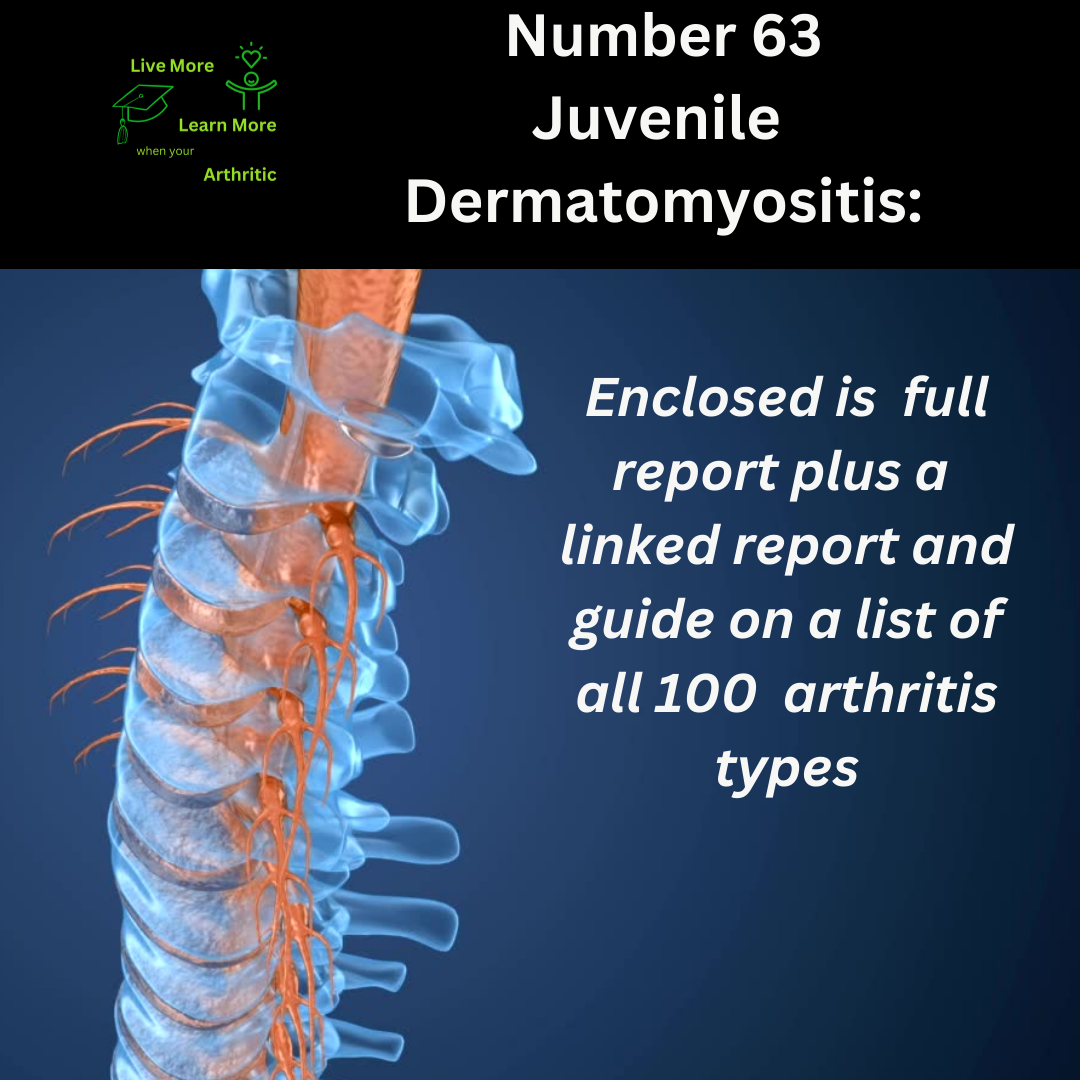
Juvenile Dermatomyositis: Number 63 on the list of 100 types of Arthritis
Juvenile dermatomyositis (JDM) is a rare autoimmune diseases that primarily affects children and adolescents. It’s a complex condition that can have a profound impact on a young person’s life, but with proper management and support, individuals can strive for a better quality of life.
 Description of Juvenile Dermatomyositis
Description of Juvenile Dermatomyositis
Juvenile dermatomyositis is characterized by inflammation of the muscles and skin. The exact cause of JDM is not fully understood, but it is believed to involve a combination of genetic predisposition and environmental triggers. In JDM, the immune system mistakenly attacks healthy muscle and skin tissue, leading to inflammation and damage.
Causes and Triggers
The underlying causes of juvenile dermatomyositis are multifactorial. Genetic factors, such as certain HLA gene variants, can predispose individuals to autoimmune diseases like JDM. Environmental triggers, such as infections or exposure to ultraviolet light, may also play a role in initiating or exacerbating symptoms.
Symptoms
The symptoms of juvenile dermatomyositis can vary but often include:
- Muscle weakness: Difficulty with activities requiring muscle strength, such as climbing stairs or lifting objects.
- Skin rash: Characteristic skin changes, such as a reddish or purplish rash on the face (often referred to as a “heliotrope” rash) and around the joints.
- Difficulty swallowing: Inflammation of the muscles in the throat can lead to dysphagia (difficulty swallowing).
- Fatigue: Persistent tiredness or weakness, which can impact daily activities.
- Joint stiffness: Limited range of motion in the joints, particularly in the mornings or after periods of inactivity.
Common Ages of Onset
Juvenile dermatomyositis typically manifests between the ages of 5 and 15 years, although it can occur at any age during childhood. The early onset of symptoms can disrupt normal childhood activities and development.
Impact on Lifespan
Juvenile dermatomyositis does not usually shorten one’s lifespan directly. However, it can lead to complications such as muscle weakness and respiratory problems, which may affect overall health and quality of life if not managed effectively.
Autoimmune Nature
Yes, juvenile dermatomyositis is considered an autoimmune diseases. The immune system targets and attacks healthy tissues, particularly muscles and skin, leading to inflammation and damage.
Achieving a Higher Quality of Life
A proactive approach to managing juvenile dermatomyositis can significantly improve quality of life. Strategies include:
- Physical therapy: Regular exercise and stretching programs tailored to individual needs can help maintain muscle strength and flexibility.
- Skin protection: Sunscreen and protective clothing can help minimize skin rash and photosensitivity.
- Nutrition: A balanced diet rich in nutrients, including anti-inflammatory foods like fruits, vegetables, and omega-3 fatty acids, can support overall health.
Possible Complications
Complications of juvenile dermatomyositis can include:
- Muscle weakness: Progressive weakness and atrophy of affected muscles, which can impact mobility and daily activities.
- Respiratory problems: Weakness of the muscles involved in breathing can lead to respiratory difficulties, particularly if the diaphragm is affected.
- Calcium deposits: Deposits of calcium in the muscles (calcifications) can cause pain and limit mobility.
 Natural Breakthroughs or Health Advantages
Natural Breakthroughs or Health Advantages
While specific natural breakthroughs related to juvenile dermatomyositis are limited, adopting a healthy lifestyle can complement medical treatment. For example, maintaining a well-balanced diet and managing stress can support overall well-being.
Gender and Age Prevalence
Juvenile dermatomyositis affects both boys and girls, although it tends to be more common in girls. The condition often begins during childhood but can persist into adolescence and adulthood.
Interconnected Diseases or Conditions
Juvenile dermatomyositis is associated with other autoimmune diseases, such as lupus and scleroderma. These conditions share common immunological features and may require similar approaches to diagnosis and management.
In conclusion, juvenile dermatomyositis is a challenging autoimmune diseases that requires comprehensive management to optimize outcomes and quality of life. With a proactive approach involving physical therapy, skin protection, and overall wellness strategies, individuals with JDM can better cope with symptoms and achieve improved well-being. Collaborating with healthcare professionals experienced in autoimmune diseases is essential for personalized care and optimal outcomes.